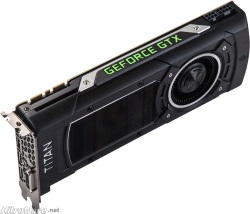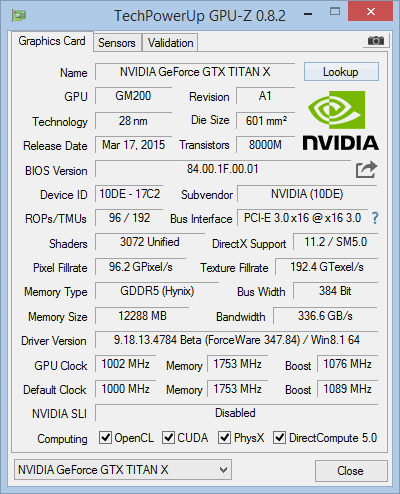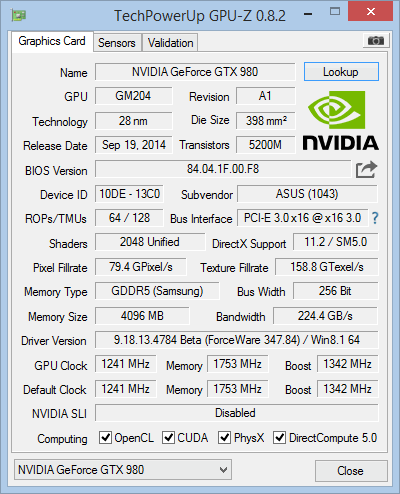TITAN X Marks the performance Spot
 At 7 TeraFlops of compute performance, claiming to be the 'worlds's fastest GPU' the single GPU TITAN X board has big shoes to fill if it wants to also take the title of worlds fastest gaming graphics card from AMD's Dual GPU, Liquid Cooled 11.5 TeraFlop Radeon R9 295 X2.
At 7 TeraFlops of compute performance, claiming to be the 'worlds's fastest GPU' the single GPU TITAN X board has big shoes to fill if it wants to also take the title of worlds fastest gaming graphics card from AMD's Dual GPU, Liquid Cooled 11.5 TeraFlop Radeon R9 295 X2.
Older NVIDIA TITAN boards were infamous for their large video memory, double precision floating point calculation and over the top pricing. Armed with Maxwell's utility belt features of Multi-Frame Anti-Aliasing, Voxel Global Illumination, display flexibility and high efficiency. NVIDIA is trying to take the new GM200 chip and TITAN X board in a different direction, aiming at users of VR and multiple 4K displays rather than a entry level board for high precision GPU Computing.
TITAN X combined with Intel's 4th Gen Haswell-E CPU and X99 platform delivers smooth frame rates at Ultra Details when paired with a 4K 60Hz display, in addition to being power efficient. Drawing 300W typical at the wall in popular titles such as Battlefield 4, Batman Arkham Origins and Crysis 3. For now, GM200 and TITAN X is the fastest single GPU money can buy but as history tells is this wont be the case for long.
GeForce GTX TITAN History and Overview
To 'hardcore' PC Enthusiasts, a GeForce GTX TITAN needs no introduction. In NVIDIA's top to bottom GPU lineup the Titan takes up what used to be the 'Ultra' board that was marketed in the late 90s and through to the late 2000s. A change in marketing for product names to simply them retired the Ultra brand.
It was not until NVIDIA achieved a design with its K20 Tesla Compute cards for the 2nd fastest supercomputer in the world, the 'TITAN' supercomputer at the US Department of Energy Oak Ridge Tennessee Labs, that the firm realised it needed to return an iconic brand to its flagship consumer GPUs.
The TITAN name stuck and from a technology perspective 'TITAN' was more a relevant and meaningful brand than 'Ultra' as at the time. The TESLA K20 Compute cards shared the same 'Kepler' architecture GK110 GPU as the pro-sumer oriented GeForce GTX TITAN board, with the name connecting the two applications.
The 'X' in Titan X actually stands for Maxwell, and is not a confusion compared to the Dual Kepler TITAN Z. The naming follows how Tegra K1/X1 are named after their respective Kepler and Maxwell architectures.
Like the first Titan which featured the 'large' GK110 GPU, 6GB of Memory, High Speed Double-Precision floating point and a high quality cooler, Titan X is also the introduction of the 'large' 3072 CUDA core GM200 GPU. Designed for optimal single precision performance, NVIDIA claims Maxwell based Titan X delivers 2X performance and 2X efficiency of the original Kepler-based Titan (when considering that the new Multi-Frame Anti-Aliasing method is used).
| Card | GTX TITAN | GTX TITAN Black | GTX 980 | GTX TITAN X | R9 290X |
|---|---|---|---|---|---|
| Pixel Fillrate (GP/s) | 40 | 43 | 72 | 96 | 64 |
| Texture Fillrate (GT/s) | 188 | 213 | 144 | 192 | 176 |
| Memory Bandwidth (GB/s) | 288 | 336 | 224 | 337 | 320 |
| Single Precision Compute (GFLOPS) | 4500 | 5121 | 4612 | 6630 | 5632 |
| Double Precision Compute (GFLOPS) | 1500 | 1707 | 144 | 192 | 704 |
| Single Precision Efficiency(GFLOPS/Watt) | 18 | 20.5 | 28 | 24.6 | 19.4 |
-
CUDA/Shader core count between Kepler 'SMX' and Maxwell 'SMM' modules on the GPU should not be compared due to architectural differences.
-
Dual GPU GTX TITAN Z board omitted for clarity, specs are slightly less than two TITAN Black
-
GTX TITAN X retains 1/32 double precision performance of GeForce
-
TFLOPS is calculated as 2x core count x clock speed. For Titan X we took the Boost clock. 2x 3072 x 1089 = 6.63 TFLOPS which correlates to NVIDIA's stated 7 TFLOPS. Other values are from wikipedia which uses base clock for calculation.
Comparing NVIDIA GTX and AMD's flagship R9 290X, NVIDIA excels in performance per watt while AMD aims for Compute Performance. On paper, GM200 is the most powerful single GPU on the market today. GTX 980 despite having less cores, has high clockspeeds hence excels at performance per watt over the Titan X, however Titan X is still faster and more powerful.
If overclocked to 1400 MHz from its base 1000 MHz speed, Titan X will achieve 8.6 TFLOPS single precision computation performance.
For our review in addition to the reference NVIDIA built GTX 980 board, we also used an ASUS Republic of Gamers Matrix Platinum GTX 980, which features beefed up power circuits, cooling and a 10% increase in fill-rates above the reference card.

